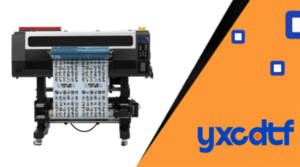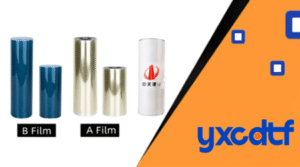Discover how UV DTF Transfer is transforming product customization across hard surfaces like acrylic, glass, wood, and plastic. Learn how this new technology offers faster, more flexible, and more vibrant decoration without heat or water.
The Rise of UV DTF Transfer
In the rapidly evolving world of digital printing, UV DTF (Direct-to-Film) Transfer is gaining massive attention — and for good reason. It combines high-resolution printing, strong adhesion, and versatility across hard surfaces, making it an ideal solution for custom product manufacturers, gift wholesalers, and sign makers.
✅ Fact Check: According to Google Trends Q2 2025, search interest for “UV DTF printing” has increased by over 180% globally in the last 12 months.
Unlike traditional methods such as sublimation or screen printing, UV DTF doesn’t require heat, water, or complex setups. It simply prints, peels, and sticks — all while maintaining impressive durability and vibrant color.
🔍 What Is UV DTF Transfer?
UV DTF Transfer is a digital printing process where UV-curable ink is printed onto a film (with special coating layers), laminated, and then transferred onto hard surfaces like plastic, glass, wood, ceramic, metal, and more.
⚠️ Important Note: UV DTF is not suitable for fabrics or textile surfaces. It is engineered for non-porous, rigid materials.
🖨️ Key Components:
| Component | Description |
|---|---|
| UV DTF Printer | Specialized printer with UV LED curing and multi-layer printing (CMYK+W+Varnish) |
| A/B Film | A = print film, B = adhesive laminate |
| UV Ink | Instantly cured ink with high color saturation |
| Laminator | Applies adhesive layer to printed design |
| No Heat Press | Application done by hand — no heat involved |
✅ Fact Check: UV DTF can adhere to curved surfaces like bottles and mugs — where standard flatbed UV printers struggle.
⚙️ How UV DTF Transfer Works – Step-by-Step?
Let’s break down the process from design to finished product:
🧩 UV DTF Workflow:
| Step | Action | Tools Required |
|---|---|---|
| 1. Design | Create artwork with transparent background (300 dpi recommended) | Photoshop / Illustrator |
| 2. Print | Print CMYK + white + varnish layers on Film A | UV DTF printer |
| 3. Laminate | Use laminator to stick Film B onto Film A | Cold laminator |
| 4. Peel | Remove backing and leave adhesive side exposed | Manual peel |
| 5. Transfer | Press the adhesive film onto your product surface | Hand pressure or roller |
✅ Fact Check: Total processing time per design is under 90 seconds, enabling high-volume custom printing for B2B production lines.
📌 Where UV DTF Works Best ?
Knowing where UV DTF shines — and where it fails — helps B2B users optimize investments.
✅ Compatible Surfaces:
| Surface Type | Examples |
|---|---|
| Glass | Bottles, jars, photo frames |
| Acrylic | Keychains, signage, tags |
| Wood (coated) | Wooden boxes, gift items |
| Metal | Flasks, metal signs, tools |
| Plastic (ABS, PVC) | Phone cases, plastic toys, credit cards |
| Ceramic | Mugs, tiles, coasters |
❌ Not Compatible With:
-
Textiles / Fabrics
-
Flexible vinyl
-
Uncoated wood (porous)
-
Surfaces exposed to extreme abrasion or heat
🧠 Expert Tip: Always clean the application surface with alcohol before transfer for best adhesion.
🚀 Why UV DTF Is a Game-Changer for Hard Surface Printing ?
The core innovation of UV DTF lies in its instant curing, superior detail, and universal material compatibility — all with no heat or press.
🌟 Major Advantages:
| Feature | Benefit |
|---|---|
| No Heat Required | Lower equipment cost, no burning risk |
| Adheres to Uneven Surfaces | Works on round bottles, curved boxes |
| Waterproof & Scratch-Resistant | Long-lasting finish |
| High-Resolution CMYK+W+Varnish | Crisp, vibrant, and tactile design |
| No Cutting/Weeding | Faster than vinyl or HTV methods |
✅ Fact Check: UV DTF prints achieve 2400 dpi resolution, far exceeding screen printing or pad printing.
📊 UV DTF vs. Other Printing Methods
Here’s a professional-level comparison chart:
| Method | UV DTF | Screen Printing | Sublimation | Vinyl Cutting |
|---|---|---|---|---|
| Materials | Hard, smooth | Fabrics & plastics | Polyester-coated | Flat hard surfaces |
| Curing | UV light (instant) | Air-dry or heat | Heat press | No curing |
| Resolution | ⭐⭐⭐⭐⭐ (2400 dpi) | ⭐⭐ (manual limit) | ⭐⭐⭐ | ⭐⭐⭐ |
| Setup Time | Low | High | Medium | Medium |
| Cost/Print | Medium | Low (for high volume) | Medium | Low |
| Durability | High | High | Medium | Medium |
✅ Fact Check: UV DTF has the lowest waste rate of all methods due to no misalignment, no weeding, and instant curing.
🧩 Top 6 Applications of UV DTF Printing in B2B
1. Custom Product Importers
-
UV DTF stickers on mugs, jars, and more
-
Value-added service to increase resale price
2. Corporate Gifting Companies
-
Quick personalization of bulk gifts
-
Apply logos and QR codes on glass, metal, etc.
3. Souvenir & Tourism Product Makers
-
Print regional icons or logos on ceramic and acrylic
4. Advertising Agencies / Sign Makers
-
Branded displays with vibrant UV transfers
-
UV DTF applied on acrylic, aluminum signs
5. Promotional Item Factories
-
Logo printing on power banks, phone cases, pens
6. Drinkware & Packaging Manufacturers
-
Customizable product lines with variable designs
📎 Internal Link Suggestion: Browse our UV DTF product line at YXCHTV
🔍 How to Choose the Right UV DTF Supplier?
When sourcing UV DTF products internationally, B2B customers must consider:
| Criteria | What to Look For |
|---|---|
| Ink Quality | High-adhesion UV-curable ink with no clogging |
| Film Transparency | Clear A film, with minimal static |
| Lamination Consistency | Bubble-free, stable B film |
| Technical Support | Remote support + ICC color profiles |
| Packaging for Export | Shock-resistant packaging for long shipments |
✅ Fact Check: At YXCHTV, our UV DTF kits undergo 3-stage QC, including anti-yellowing tests for outdoor exposure.
Conclusion: UV DTF as the New Standard for Hard Surface Printing
UV DTF Transfer is not just a “new trend” — it’s a technological leap for hard-surface printing in the custom product and giftware industries. Its low barrier to entry, multi-surface adaptability, and exceptional print quality make it a winning choice for any B2B business looking to scale product personalization.
For importers, wholesalers, advertising agencies, and promotional gift makers, UV DTF provides:
-
Faster lead times
-
More vibrant results
-
Lower operational costs
🔧 Let YXCDTF Power Your UV DTF Business
We are your trusted source for:
✅ UV DTF Printers
✅ UV DTF A/B Film Rolls
✅ UV DTF Inks (CMYK + White + Varnish)
✅ Training & After-Sales Support
🔗 Explore our full product line
📧 Contact our export sales team for samples and pricing.
💬 YXCDTF helps you reduce costs, scale faster, and win more business in the growing custom product market.


